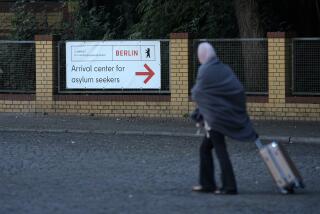Last 6 E. Germans End Asylum Vigil in Prague
- Share via
BONN — One of the largest and most prolonged mass attempts to flee to the West in recent years ended quietly in defeat early Tuesday when the last six of more than 160 East German asylum-seekers left the West German Embassy in Prague to return home, Foreign Ministry officials here said.
Their departure appeared to signal the end of an escape route via Western embassies in the East Bloc, which brought freedom to more than 100 East Germans in the last year.
The latest attempt began Sept. 13 and at its height in November involved more than 160 East Germans, many of them entire families. When the Bonn government was finally forced to close the embassy’s gates in October, several families scaled the mission’s perimeter fence to gain entry.
Move to End Escapes It soon became clear that the East German government, previously more interested in defusing an embarrassing crisis than retaining groups of discontented citizens, had decided to stop the escapes.
Protracted negotiations between the two Germanys over release of the asylum-seekers broke down last month. East German authorities insisted that the refugees return home but agreed not to arrest them. They also agreed to permit the refugees to apply for an exit permit once home but, in contrast to previous instances, refused to guarantee that the permits would be granted.
Although it was never confirmed here, it is believed the East German authorities also insisted that they would not consider exit permits for any of the 160 until all asylum-seekers had left the embassy and returned to East Germany.
70 Went on Hunger Strike On Dec. 14, 40 of the 70 asylum-seekers still in the Prague embassy began a hunger strike in hopes of pressuring the East Germans into guaranteeing them exit permits. During the course of the hunger strike, senior West German government officials, including Foreign Minister Hans-Dietrich Genscher, visited the embassy, attempting to convince the refugees that they stood no chance of success.
After two weeks, the hunger strike ended, and on Jan. 2 the first large group departed for home.
East Germany granted more than 40,000 exit permits last year, the most in any one year since the Berlin Wall was built in 1961. However, an estimated 400,000 others who have requested permission to leave, many of them years ago, are still waiting. The route through diplomatic missions was seen as a way to eliminate the wait, as well as the possibility of being turned down.
Officials in Bonn’s Ministry of Inner-German Relations on Tuesday vowed to monitor closely the progress of exit permit applications.
“We will be checking on each and every case,” said Ottfried Henninger, the ministry’s senior civil servant.
Meanwhile, in a warning to other East Germans thinking of attempting to flee via a Western embassy, East Germany publicly declared an end to its policy of not arresting those attempting to escape this way.
Attempts to flee through Western missions in the East Bloc began a year ago when six East Germans sought refuge in the U.S. mission in East Berlin. Those six plus 12 others who declared for asylum in the West German mission in East Berlin were permitted to leave directly for West Germany after brief negotiations.
Premier’s Niece Flees In a series of incidents over the ensuing six months, about 90 others eventually gained their freedom via the West German missions in East Berlin and Prague. Among them was Ingrid Berg, niece of East German Premier Willi Stoph, and her husband, two children and mother-in-law.
As the Prague embassy filled up last October, East Germans also fled into West German missions in Bucharest, Warsaw and Budapest. Last week, more than 20 East Germans gave up similar sit-ins in those Warsaw and Budapest missions to return home.
A West German government spokesman said it has not yet been decided when the Prague embassy will reopen for normal business.
More to Read
Sign up for Essential California
The most important California stories and recommendations in your inbox every morning.
You may occasionally receive promotional content from the Los Angeles Times.













